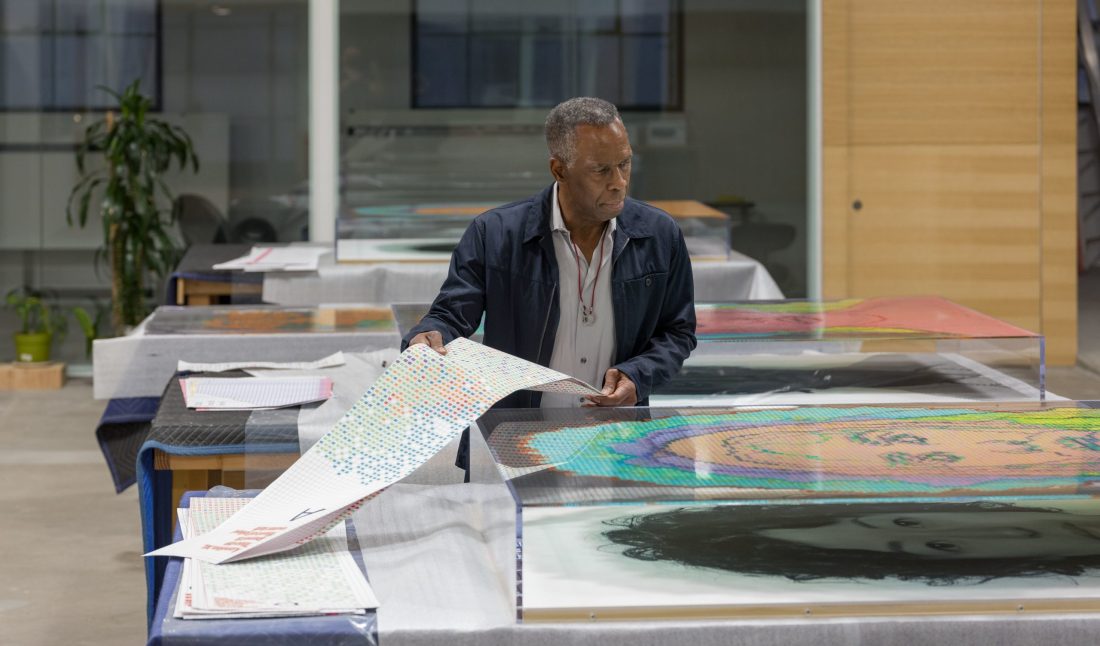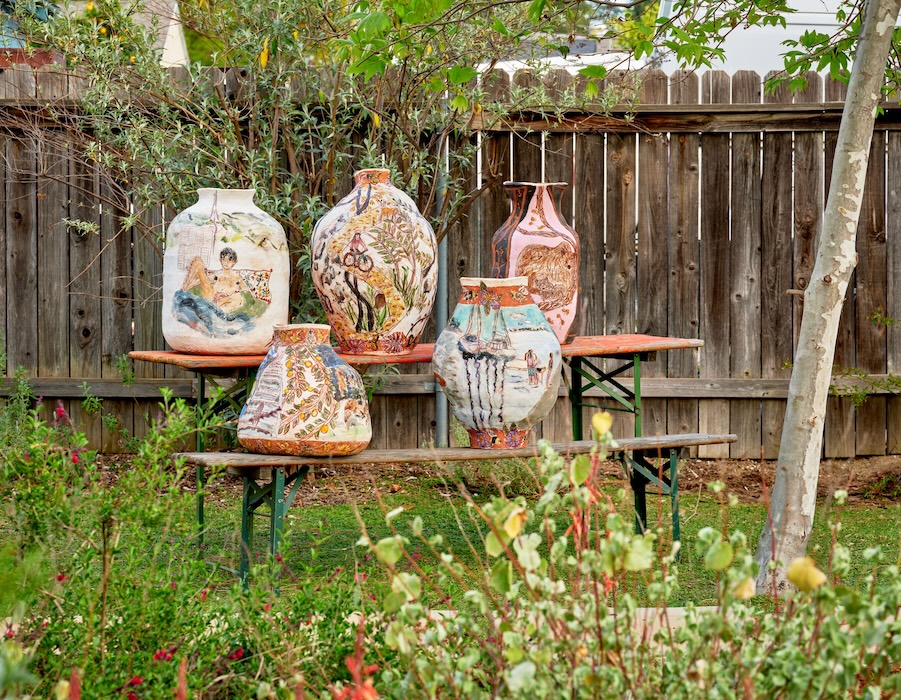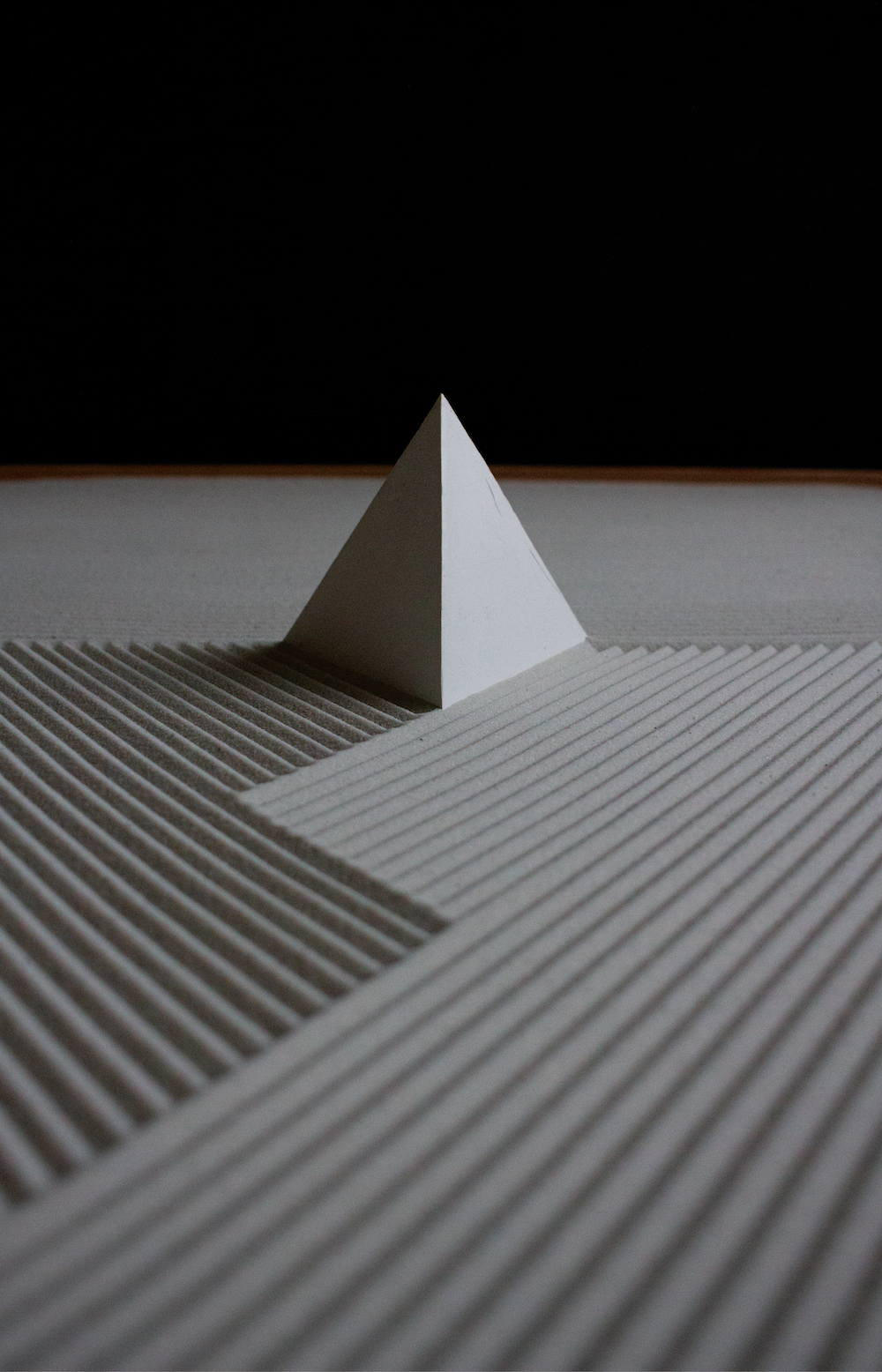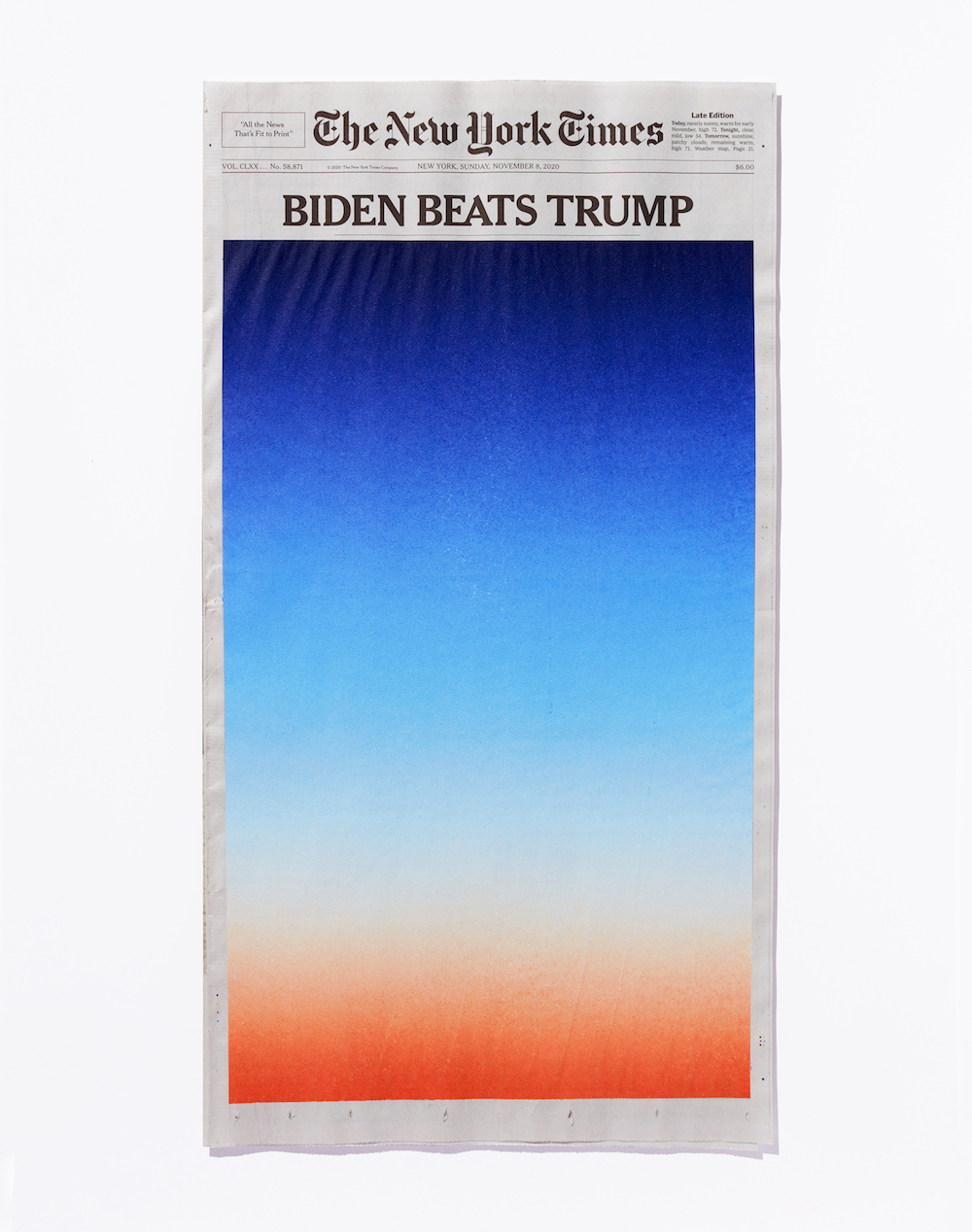Charles Gaines’s well-known Plexiglas gridworks, featuring images of trees and faces layered with plotted drawings in progressive sequences of color, feel tightly controlled from beginning to end. But in reality, while their beginnings are based in a clear set of rules, the final objects are something the artist cannot predict, merely the result of a system laid out at the onset.
The latest in his ongoing series of “Trees” and “Faces,” was on view at Hauser & Wirth in London through May 1, 2021, features a slight alteration in the system, which produced a range of surprising outcomes for Gaines. Whether in his gridworks, or “Manifestos” and “Skyboxes,” which arbitrarily conflate sound and light with political texts (recent examples of which are installed this spring at SFMOMA), Gaines’s practice uses systems and formulas to challenge the very notion of subjectivity in art. He argues that objects made by an artist, and in turn how audiences perceive that artist, are inextricably framed by the cultural fabric from which we come.
Whitewall spoke with Gaines about addressing contemporary conversations around identity politics in his newest series, as well what led him to establish a fellowship for Black MFA students at CalArts, where he has taught for over three decades.
WHITEWALL: Let’s start with the Hauser & Wirth show in London, where you’re showing two new bodies of work from your “Numbers and Trees” and “Numbers and Faces” series. How did “Numbers and Trees: London Series 1” come together?
CHARLES GAINES: I visited London and had the opportunity to meet one of the directors of the gallery. He said, “Let me take you on a tour of these British oaks, they are the most amazing trees.” And so we went around the countryside and looked at the trees. We went on a reconnaissance mission in Dorset and found these incredible deer preserves with these extraordinary oak trees.
In the series, I didn’t want to continue what I was doing even though the subject was the same. I thought in this one I would change it up a little bit. I was surprised by the results. As we developed the works, I was quite excited by the fact that as the visual image, it looks considerably different and was doing different things than the previous work in this body.
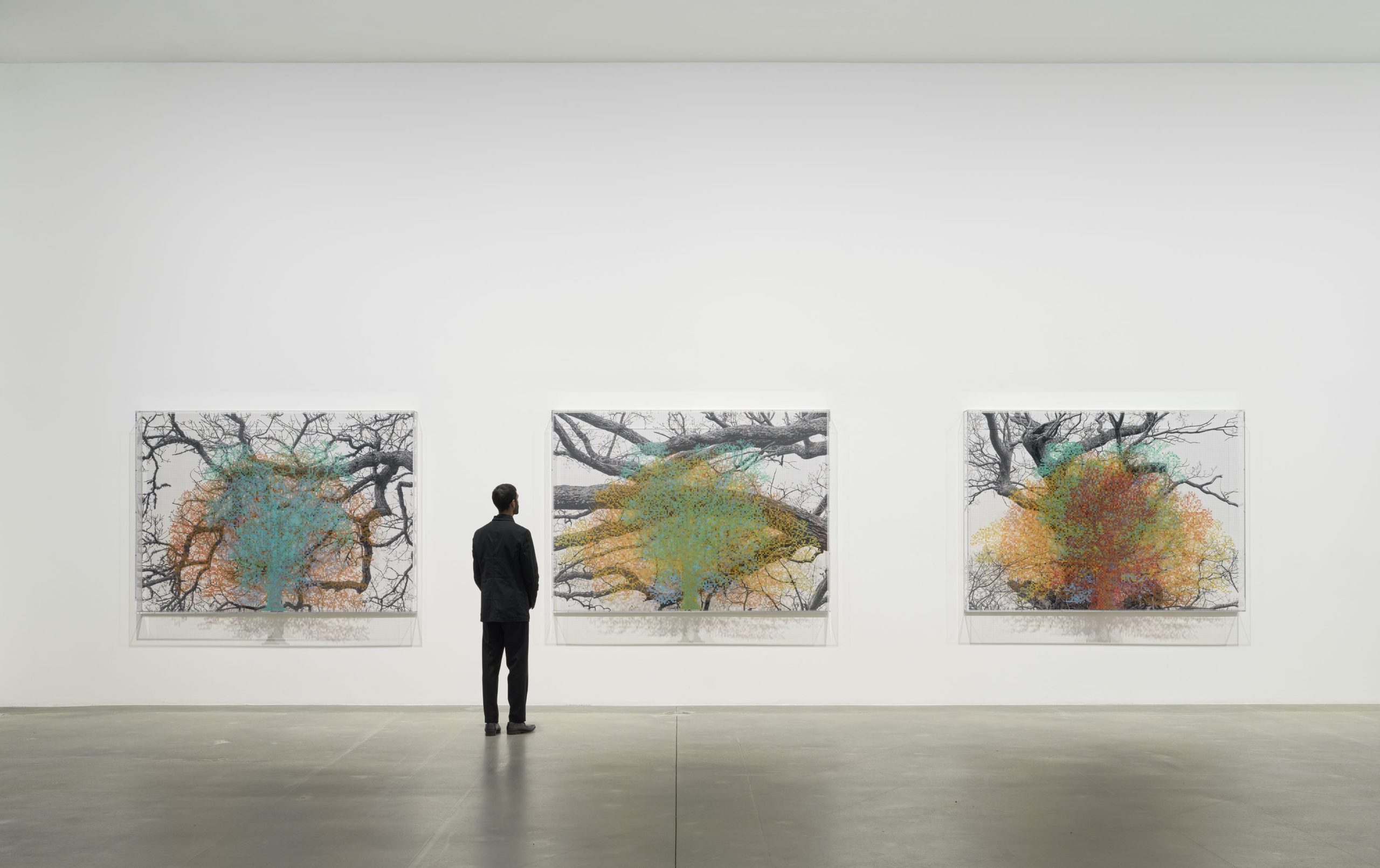 Installation view of “Charles Gaines: Multiples of Nature, Trees and Faces,” Hauser & Wirth London, online from January 29–May 1, 2021, photo by Alex Delfanne, © Charles Gaines, courtesy the artist and Hauser & Wirth.
Installation view of “Charles Gaines: Multiples of Nature, Trees and Faces,” Hauser & Wirth London, online from January 29–May 1, 2021, photo by Alex Delfanne, © Charles Gaines, courtesy the artist and Hauser & Wirth.
WW: And how did you approach “Numbers and Faces: Multi-Racial/Ethnic Combinations Series 1”? How were your subjects chosen?
CG: In the original “Faces” series there was no narrative subject. They were simply dealing with the face as an object. I remember at that time various questions about the identity of the people that I photographed. Since I wasn’t interested in their identity, I didn’t have much to say. But over the years, in other works, I started to try to figure out how to introduce the political subject more directly in my work.
So in this series, I simply metaphorized the idea of the layering into a genealogical framework—taking a cue from biology, saying that the system of layering could be looked at as a biological metaphor of the propagation, seriation of a family. That allowed me to think about the faces politically.
WW: Why were you interested in introducing politics into the work?
CG: At the time there was a lot of talk where the political right was trying to delegitimize the idea of identity and identity politics. That identity politics becomes similar to a bunch of progressives “pulling out the race card,” “pulling out the identity card.” They tried to reduce it to a strategy of the political left to get attention that they didn’t deserve.
I thought I’d address the idea that identity is a very old category in philosophy and psychology that starts with the perceptions of the self. It’s evolved over two thousand years where the notion of self and identity and the notion of the human are trying to be worked out by philosophers and psychologists. To that end, I selected these major figures in the history of self and identity starting with Aristotle, but going through Edward Said, and these various figures and writers on the subject. I overlaid their faces in order to make the point that to trivialize the idea of identity is racist, because it’s stereotyping and reducing a legitimate serious area of knowledge acquisition.
In this piece, again the biological metaphor is applied to systematic seriations of faces and layers. I decided to deal with the issue of race and ethnicity. The people who I photographed were people who self-identified as multiethnic or multiracial. That self-identification of race and ethnicity in each work in the series, between the process of layering and merging that happens progressively over the course of the series, approximates or analogizes the idea of genetic virtue.
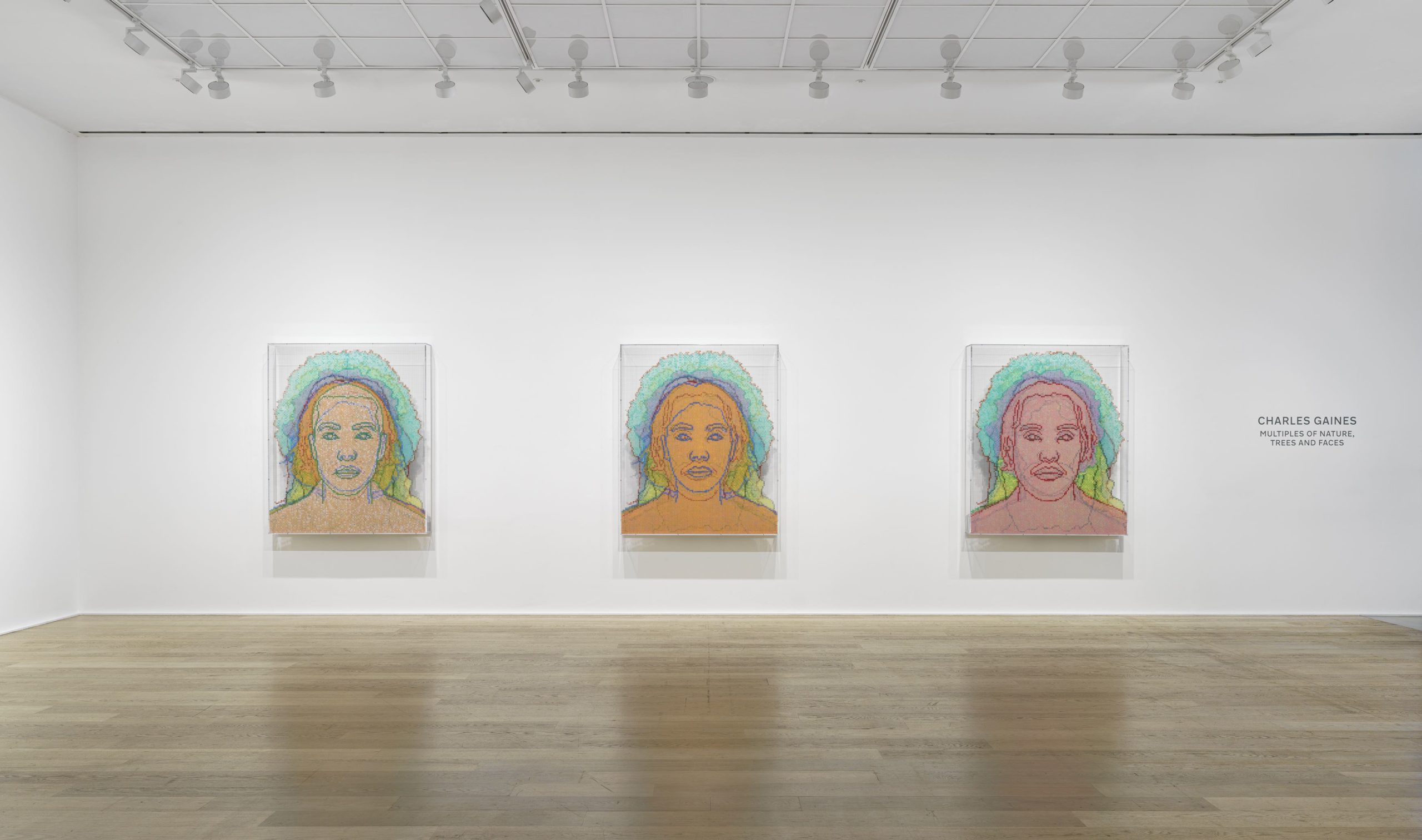 Installation view of “Charles Gaines: Multiples of Nature, Trees and Faces,” Hauser & Wirth London, online from January 29–May 1, 2021, photo by Alex Delfanne, © Charles Gaines, courtesy the artist and Hauser & Wirth.
Installation view of “Charles Gaines: Multiples of Nature, Trees and Faces,” Hauser & Wirth London, online from January 29–May 1, 2021, photo by Alex Delfanne, © Charles Gaines, courtesy the artist and Hauser & Wirth.
WW: You critically explore subjectivity in your practice. How was that done in this series?
CG: My rule-based work presents an attack on the idea of subjectivity— that works of art are produced from the subjectivity of the artist, and the trace of that subjectivity itself is invisible, the only material is the produced form or object. I wanted to critique that linkage, to say that what is produced is actually a product of culture and your individuality is part of that complex cultural fabric that results in the produced object.
The system shows the evidence of the subject is submerged in the face of the system, because the system produces all these effects that have nothing to do with the intention of the producer or those markers of the subject. And on top of that, it shows this unpredictability that is a consequence of the production. As you watch the system unfold over the series, that obfuscation of evidence becomes more and more present as it gets lost in the layering of these different elements using this very predictable system. The system is very predictable, but it produces something more on the level of chaos than order at the end.
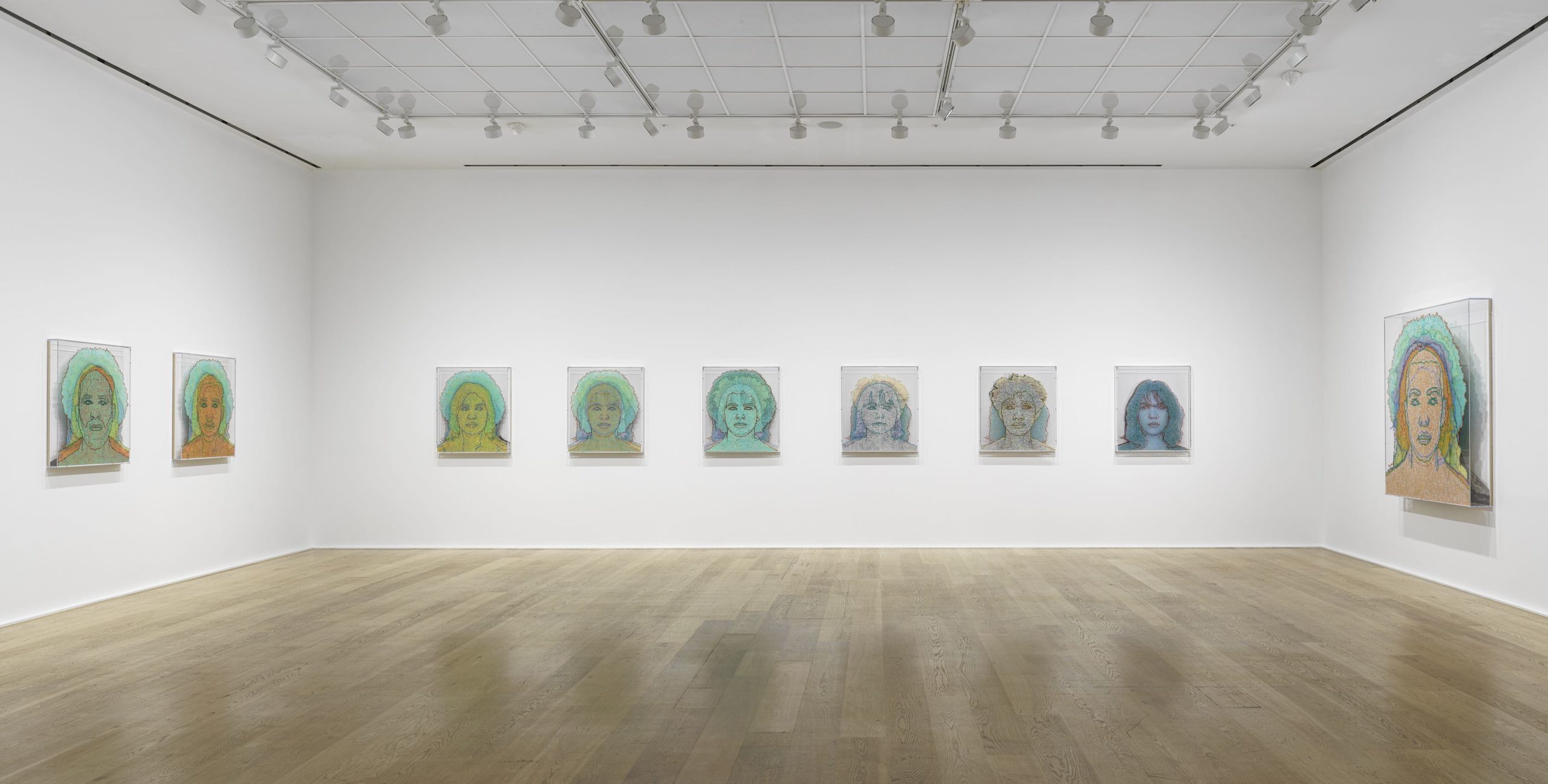 Installation view of “Charles Gaines: Multiples of Nature, Trees and Faces,” Hauser & Wirth London, online from January 29–May 1, 2021, photo by Alex Delfanne, © Charles Gaines, courtesy the artist and Hauser & Wirth.
Installation view of “Charles Gaines: Multiples of Nature, Trees and Faces,” Hauser & Wirth London, online from January 29–May 1, 2021, photo by Alex Delfanne, © Charles Gaines, courtesy the artist and Hauser & Wirth.
WW: What is the process is like for you, starting with a clear set of rules, but the end result you compared to something like chaos? There is this element of control in the making, but the result you don’t have control over.
CG: What we call the creative art is creating the system, but creating the system is very arbitrary. There is no ideology that is built into the system that you create. I say, “Well, I’m going to trace the shape of people’s heads, and layer them over 10 to 12 pieces and I’ll assign each layer a color so I can differentiate the heads from each other.” I use a grid in order to take subjectivity out of its composition. And then I layer it and what happens always turns out to be a wonderful surprise to me because I’m not designing the piece. Once that system is developed, it realizes itself in a way the rules allow.
We’re used to looking at forms in art as products of a subjective expression. And this has to do with how we respond to a work of art. My claim is that I could get you to respond to that through a system, not some obscure source. You know exactly why this is put into place, and you can respond to it critically and aesthetically, but that mark is not a signal coming from some invisible subject.
I wanted to show that what you’re responding to when you look at a work of art is actually something that is articulated and framed within the constraints of a culture, meaning that what you bring to a work of art are things that you learn. You can’t engage it as an isolated function in the way that modernism tried to propose over the years. It is already mediated by the interest and concerns of culture. And thus, the critique that I want to make to dismantle this notion of the idea of the autonomous art object, an art object that can be considered a pure object of expression, that is disconnected and unmotivated from the interest of others. It makes even the idea of aesthetics more of a political construct, one informed by culture, rather than being something that only exists in the absence of culture.
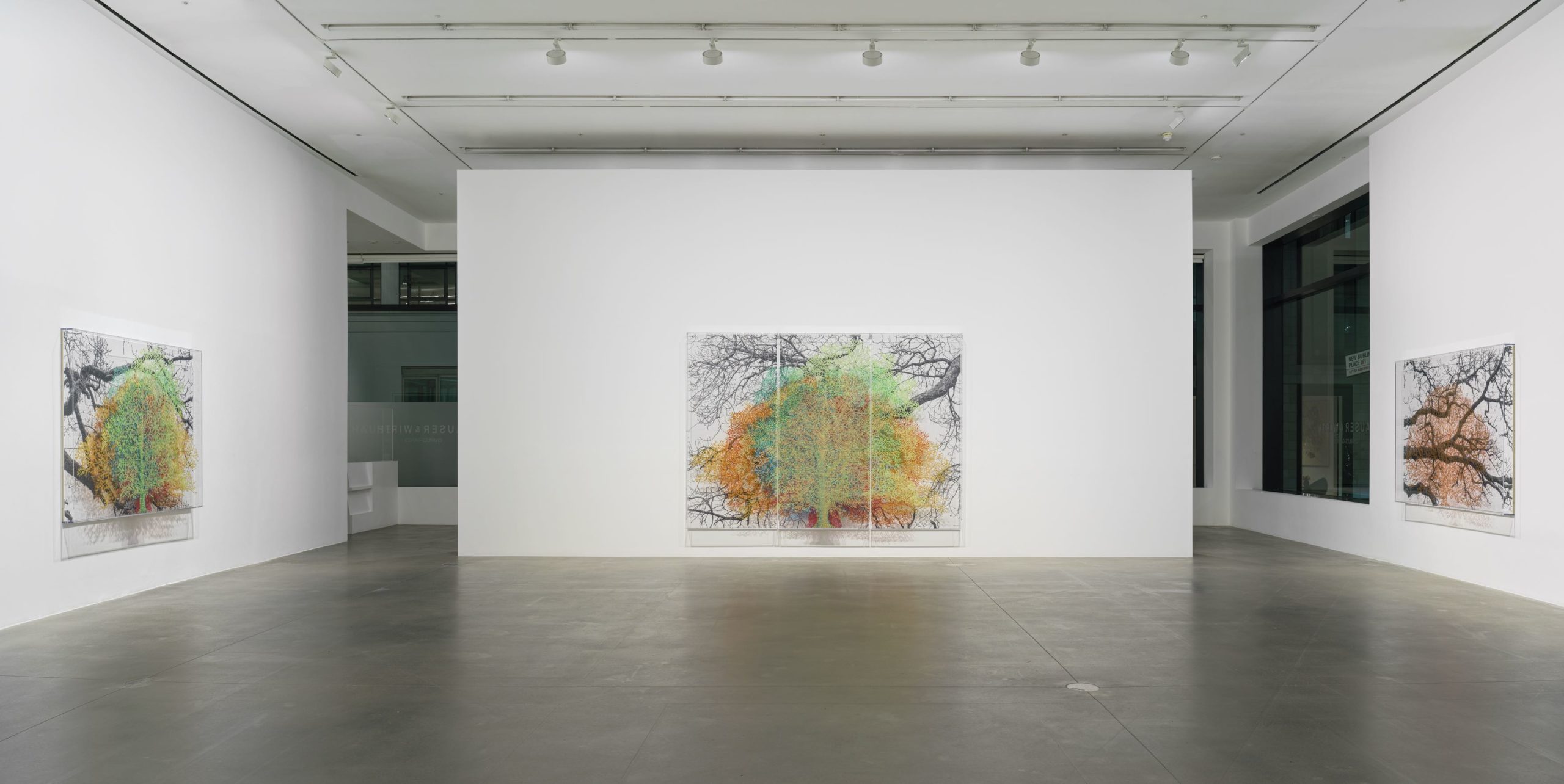 Installation view of “Charles Gaines: Multiples of Nature, Trees and Faces,” Hauser & Wirth London, online from January 29–May 1, 2021, photo by Alex Delfanne, © Charles Gaines, courtesy the artist and Hauser & Wirth.
Installation view of “Charles Gaines: Multiples of Nature, Trees and Faces,” Hauser & Wirth London, online from January 29–May 1, 2021, photo by Alex Delfanne, © Charles Gaines, courtesy the artist and Hauser & Wirth.
WW: You have a show this spring as well at SFMOMA, featuring Manifestos 4 (2020) and Skybox 2 (2020). Can you tell us about those works?
CG: Manifestos is a relational piece where I select political manifestos from research. I translate the letters of the political text into musical notation. It’s a system where I produce music by transmitting the text into musical notation by following the sequence of the text, not by trying to create melodies. I write an arrangement from the translation for an ensemble, record that, and in the installation we have a monitor that scrolls the political manifesto and the soundtrack. We do these graphite drawings of the music manuscript that is produced according to systems so you can follow along.
It’s like the effect of color in my grid box series. The sentiment and emotion that is produced by the work, even though it is rule-based, people believe they’ve connected so keenly these certain instances that happened that they feel that I designed it. But then I tell them no, the first time I hear the music in relation with the text is when we record it. I don’t know what this is going to produce.
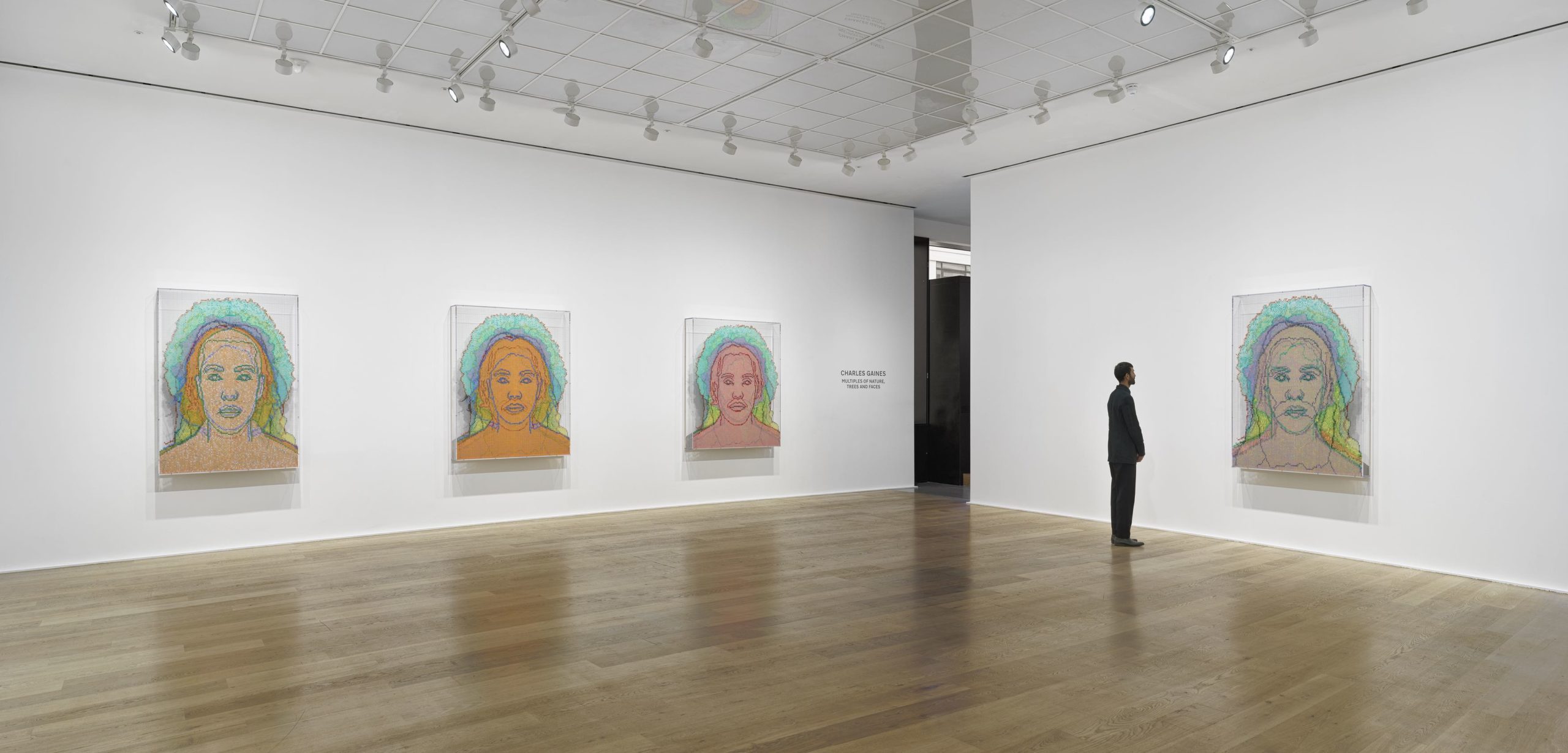 Installation view of “Charles Gaines: Multiples of Nature, Trees and Faces,” Hauser & Wirth London, online from January 29–May 1, 2021, photo by Alex Delfanne, © Charles Gaines, courtesy the artist and Hauser & Wirth.
Installation view of “Charles Gaines: Multiples of Nature, Trees and Faces,” Hauser & Wirth London, online from January 29–May 1, 2021, photo by Alex Delfanne, © Charles Gaines, courtesy the artist and Hauser & Wirth.
WW: And how do you make the Skybox installation?
CG: I did a piece called “Night/Crimes,” where I took photographs of crime scenes and matched them with photographs of the night sky. I laid them systematically by establishing that the sky that’s in the photograph was the sky present at the moment of the crime. If the victim and the criminal looked up at the sky, they would see that sky. That was a narrative, symbolic linkage between the two.
What that link did is it changed the way you saw the crime and connected it to transcendental theories or notions of the mystical, in the way that we think stars are connected to our individual lives through astrology. Or even in physics, that the moon can change our moods and in the same way that the moon influences the ocean tides. Which adds this area of poetry and affect to this literal linking of two different and completely separate events. There is no relationship between the night sky and the crime. There’s really not. But I narrate one in this framework.
I took that idea in developing the “Skybox” series, but in this case I don’t use a photograph; I use the political texts like in the manifestos. And these texts are on the face of the Plexi box. What you can’t see when you walk into the installation is the Plexi boxes have tiny holes drilled into them. At a certain point when you are looking at the text, the light begins to dim, it gets darker and darker, and at a certain point it becomes an image of the night sky. When it’s completely dark it’s amazing. It looks like you’re floating in space. When you’re immersed in total darkness, you literally float. And like the music pieces, it produces this space of affect, this space of sentiment, and again, it’s an arbitrary conflation.
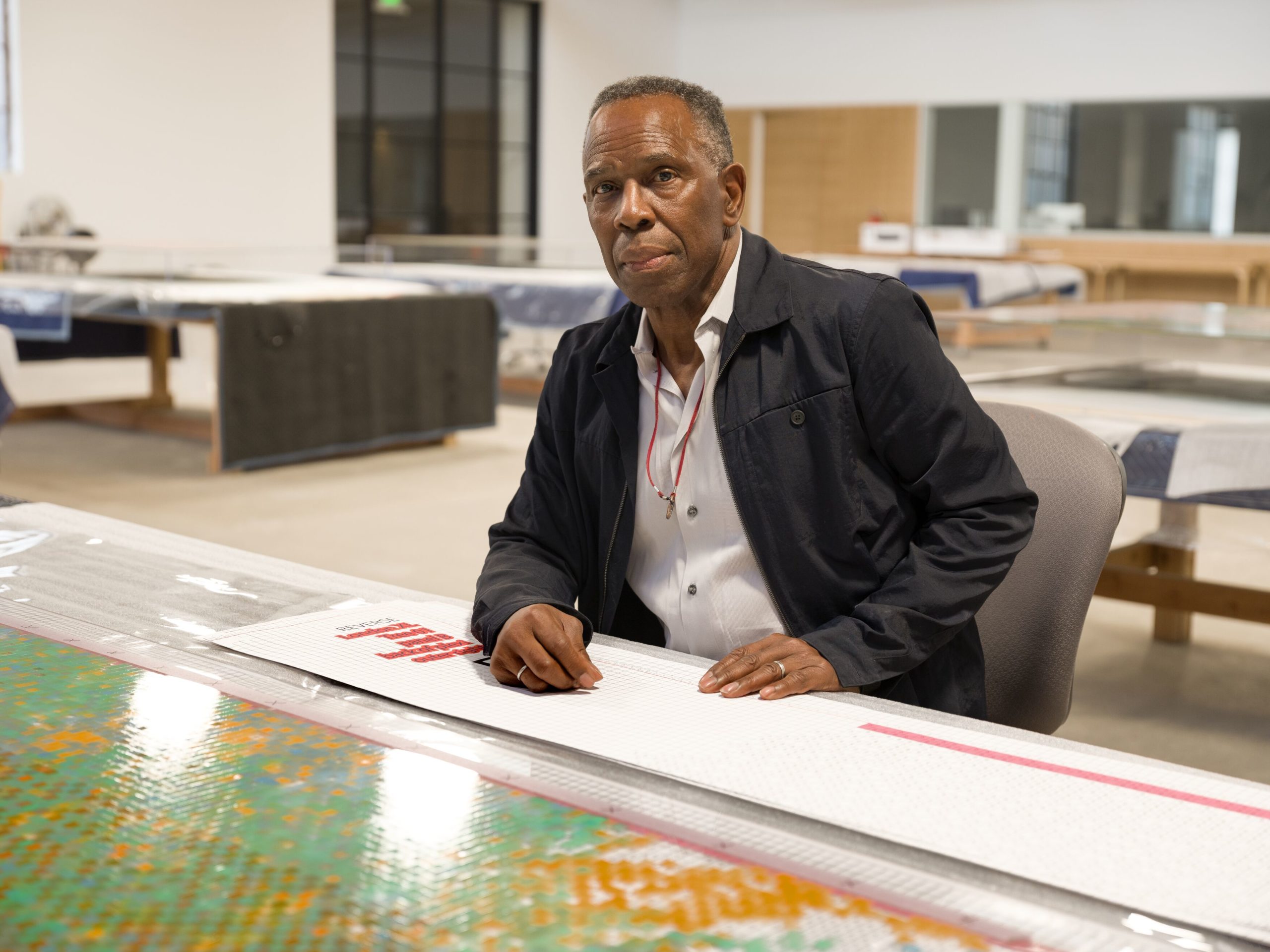 Charles Gaines in his Los Angeles studio, 2020, © Charles Gaines, photo by Fredrik Nilsen, courtesy of the artist and Hauser & Wirth.
Charles Gaines in his Los Angeles studio, 2020, © Charles Gaines, photo by Fredrik Nilsen, courtesy of the artist and Hauser & Wirth.
WW: What inspired the fellowship that you established last year for Black students in the MFA program at CalArts?
CG: When I first started teaching at CalArts, it’s a private school, and I noticed there weren’t many minorities, both at the level of students as well as the faculty. I was the first Black faculty that CalArts have ever hired full time. I argued and argued, but it didn’t seem to be a problem for anybody.
The minority population of the United States has one tenth the earning power of the Euro white American population. As a population, they can less afford private school. Things left as they are wasn’t going to do anything about this segregation that was going on. And if there’s an opportunity to get minority students, you couldn’t compete because they would get scholarships from other schools. I thought this was a problem, and for years myself and other faculty had been trying to generate an interest in the school to develop minority scholarships. But we were never able to do anything about it.
I had been cutting back on my teaching, and my career professional career is doing pretty well, so I thought maybe the way to get a scholarship was if I started one myself. I couldn’t get anybody else interested in doing it. So I made the proposal that I would contribute to two scholarships over two years. But the caveat is a matching partner. I wanted to support four scholarships over two years. One of my collectors stepped up to the plate and gave the matching funds.
That then started a whole series of contributions going. We also are pretty close to making these scholarships permanent by building an endowment. I have to say that part of this is able to work for several reasons. One was this heightened interest in awareness in racism in America with the Black Lives Matter movement. It was becoming clear to everybody who didn’t vote for Trump that America is deeply entrenched in racism and it is very, very difficult to be a minority in the United States. It’s really hard. There is this heightened interest and more people wanting to make a positive contribution to that. I think that was going on among some of the people who donated to the program.
WW: And getting an MFA at CalArts will make a huge difference for a young artist.
CG: Oh, yeah. I think over the 30 years I was teaching, the total number of Black students we had was like 26. But of that 26 people, there’s a certain number who become quite prominent. So that few number of minority students outperformed their white peers in terms of careers. That shows me that coming to CalArts can have that effect. All you have to do is make it possible for people of color to come.
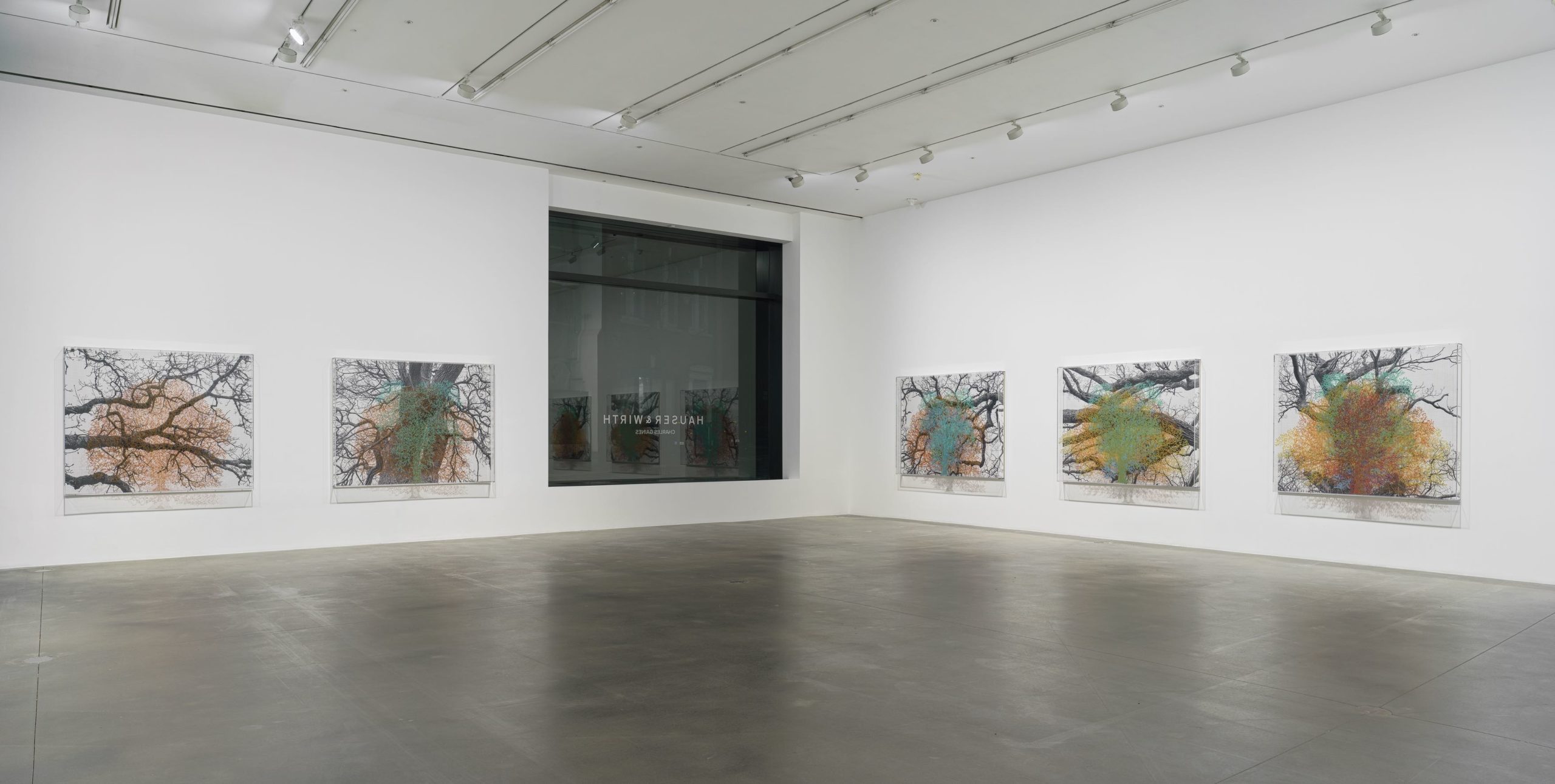 Installation view of “Charles Gaines: Multiples of Nature, Trees and Faces,” Hauser & Wirth London, online from January 29–May 1, 2021, photo by Alex Delfanne, © Charles Gaines, courtesy the artist and Hauser & Wirth.
Installation view of “Charles Gaines: Multiples of Nature, Trees and Faces,” Hauser & Wirth London, online from January 29–May 1, 2021, photo by Alex Delfanne, © Charles Gaines, courtesy the artist and Hauser & Wirth.






